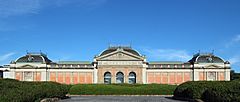Kyoto National Museum facts for kids
| 京都国立博物館 | |

Façade of museum
|
|
| Lua error in Module:Location_map at line 420: attempt to index field 'wikibase' (a nil value). | |
| Established | May 1897 |
|---|---|
| Location | Higashiyama-ku, Kyoto, Japan |
| Type | Art museum |
| Visitors | 384,340 (2016) |
| Public transit access | Shichijō Station, Keihan Main Line |
| Kyoto Museums Four | |
|
|
The Kyoto National Museum (京都国立博物館, Kyōto Kokuritsu Hakubutsukan) is one of Japan's most important art museums. It's located in Kyoto, a city famous for its history and culture. This museum is a special place where you can explore amazing art and historical items from Japan and other parts of Asia. Most of these items are from before modern times.
Contents
History of the Museum
The idea for the Kyoto National Museum came about in 1889. Two other museums, in Tokyo and Nara, were also planned at the same time. Construction on the Kyoto museum finished in October 1895. It officially opened its doors in 1897.
Over the years, the museum's name changed a few times. In 1900, it became the Imperial Household Museum of Kyoto. Then, in 1924, it was renamed the Imperial Gift Museum of Kyoto. Finally, in 1952, it received its current name: the Kyoto National Museum.
Key Moments in Museum History
Here's a quick look at how the museum grew over time:
- 1897—The museum opened as the "Imperial Museum of Kyoto."
- 1900—Its name changed to the "Imperial Household Museum of Kyoto."
- 1924—The museum was given to the City of Kyoto. It was then called the "Imperial Gift Museum of Kyoto."
- 1952—The national government took over the museum's collections. It was renamed the "Kyoto National Museum."
- 1966—A new building, the Collection Hall, was finished.
- 1969—Several parts of the museum were named "Important Cultural Properties." These included the Special Exhibition Hall and the Main Gate.
- 1973—The museum started its Saturday Lecture Series for visitors.
- 1979—A special center for preserving cultural items was completed.
- 2001—A new South Gate was built. The museum also became part of the "Independent Administrative Institution National Museum."
- 2005—The Kyushu National Museum joined this group of national museums.
- 2007—The national museums joined with other cultural preservation groups. This created the "Independent Administrative Institution National Institutes for Cultural Heritage."
Museum Buildings and Layout
The Kyoto National Museum has several important buildings. The Special Exhibition Hall, also known as the Main Exhibition Hall, was designed by Katayama Tōkuma in 1895. Another key building is The Collections Hall, designed in 1966 by Morita Keiichi.
In 2014, the museum finished updating a new permanent collections hall. This is called the Heisei Chishinkan Wing. It was designed by Yoshio Taniguchi, who is famous for his work on the Museum of Modern Art in New York. He also designed the Gallery of Hōryū-ji Treasures at the Tokyo National Museum.
The museum uses The Collections Galleries for its regular displays. The Special Exhibition Hall is used for temporary exhibits that change over time. The Main Exhibition Hall, the Main Gate, and the Ticket Area are all recognized as Important Cultural Properties. This means they are very important historical buildings.
Amazing Museum Collections
The museum was first built to show off art treasures. Many of these treasures were privately owned by temples and shrines. Some items were also given by the Imperial Household Ministry. Today, most of the items you see at the museum are on loan from these places.
The museum mainly focuses on Japanese art from before modern times. It has a very large collection of items from the Heian period (794-1185 AD). It also has many pieces of Asian art. The museum is also well-known for its rare and old Chinese and Japanese sutras (Buddhist scriptures). Other famous works include an 11th-century landscape screen called senzui byōbu. There's also the gakizōshi (Scroll of Hungry Ghosts) from the 12th century.
The museum's collections are divided into three main parts:
- Fine Arts: This section includes beautiful sculptures, paintings, and works of calligraphy (artistic writing).
- Handicrafts: Here you can find amazing pottery, fabrics, lacquerware (items coated with a special varnish), and metalworks.
- Archaeology: This part displays objects found from ancient times. These items help us learn about history.
In total, the museum has over 12,000 works. About 6,000 of these are usually on display. The museum also has a huge collection of over 200,000 photographs of cultural items. In the Fine Arts collection alone, more than 230 pieces are considered either National Treasures or Important Cultural Properties. These are the highest levels of cultural importance in Japan.
See also
 In Spanish: Museo Nacional de Kioto para niños
In Spanish: Museo Nacional de Kioto para niños
- List of National Treasures of Japan (ancient documents)
- List of National Treasures of Japan (archaeological materials)
- List of National Treasures of Japan (crafts-others)
- List of National Treasures of Japan (crafts-swords)
- List of National Treasures of Japan (paintings)
- List of National Treasures of Japan (writings)

